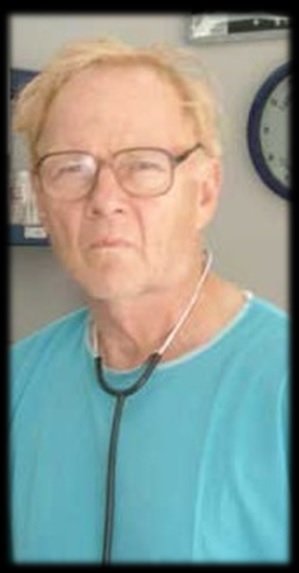




January 2011
In May 1998, National City (California) police officers respond to a call of a body in room 609 of the Holiday Inn. A seventy-nine-year-old retired engineer from New York named Philip Bondy was missing his left leg just above the knee.
The corpse was lying half on the bed with the sheets pulled out. Blood oozed from a blackened and gangrenous stump. The phone was tipped over and a wheelchair upsided.
Deputy District Attorney Stacy Running later recalled Bondy looked like a concentration camp inmate. "He was very thin, very emaciated. There was not an ounce of excess flesh. Skin on his face followed the skull. The mouth was open. It looked like he was screaming or crying when he died — to God or I don’t know whom."
It was obvious Bondy didn't have a peaceful death. The cause of death was determined to be clostridia perfringens (also known as gaseous gangrene), a fast-moving flesh-eating bacteria that lowers blood pressure and causes the heart to stop.
Detective Gary Stovall pulled the case. Despite the bizarre circumstances, it wasn’t completely clear a crime had been committed.
A friend of Bondy initially told police he'd been in a taxi accident in Mexico and required immediate surgery in a Tijuana clinic. That didn’t make sense. If Bondy had been in an accident, why didn’t he have other injuries? Why didn’t the local police know anything about it?
Strangest of all: why did Bondy have two $5,000 receipts in his room, one for "surgery" and the other for "hospitalization," both signed by an American doctor named John Ronald Brown?
Stovall tried calling Dr. Brown. Three unreturned messages later he drove to Brown's San Ysidro apartment and knocked on the door. Brown answered. Detective Stovall asked him if he knew why he was there. Brown replied," It’s because of the man who died in the hotel room in National City."
Detective Stovall recalled Brown as non-threatening, polite, well-spoken and obviously well-educated. It was clear Brown was not someone for whom personal appearance was a high priority. His apartment smelled like garbage. The couch was bloodstained and the stuffing was falling out. The stove was filthy. The sink was stacked with dirty dishes.
There were books, professional journals, travel bags and medical supplies scattered about the floor. Stovall later said, "if a child had been living there, I’d have put him in a foster home."
When Stovall asked Brown to come down to the police station, the doctor put on a wrinkled shirt and stained jacket.
Once at NCPD Headquarters Brown initially said he didn't want to talk. He then offered a statement that ended up being twenty nine pages.
Brown didn't admit to the amputation but did confess he drove Bondy to the clinic then visited the Holiday Inn the next day to inspect the wound.
Brown also admitted he observed the wound taking on a pale-blue tint, an indication of emerging gangrene.
Detective Stovall left the interview room to tell his superiors he was going to arrest Dr. Brown.
Meanwhile, Brown apparently didn’t even realize that he was in trouble and casually walked out of the station to head home.
He was two blocks away when suddenly two police cars appeared and took him back into custody.
Brown said he had become bored and had nothing to read so he simply left.
If the arrest amazed Brown, his arraignment dumbfounded him.
Deputy District Attorney Stacy Running asked the judge to hold him without bail on the grounds that he was an "incredibly dangerous individual to the citizens both of the United States and Mexico."
Brown later told a reporter none of this made sense, either legally or morally. "I didn’t think any laws had been violated on either side of the border. From now on, is every surgeon who performs an operation where the patient later dies of infection going to be arrested for murder?"
With Brown behind bars, investigators began looking into his past. The results were startling.
Brown was seventy-six-years-old at the time of his arrest and had been a doctor since 1947. Once regarded as brilliant for scoring first out of 300,000 on Army assessment tests, Doctor Brown worked as a general practitioner for almost two full decades before he decided he wanted to become a surgeon.
Brown excelled in the written aspects of certification for the American Board of Plastic Surgery however he failed the oral assessment. Brown said he passed the written part of the exam without cracking a book. The problem was the orals - a failure he blamed on a domineering father.
By the early 1970s, Brown was running a San Francisco clinic where he carried out sex reassignment surgery. Brown's clientele were primarily people who were either too poor to afford the fees of reputable surgeons or those rejected by Stanford and Johns Hopkins for not being able to meet the exceptionally strict criteria for surgery.
In his marketing Brown freely admitted he was willing to operate on anybody who would pay him.
Brown's medical license was revoked in 1977 following the death of one patient and a lawsuit from another. Charges were gross negligence, incompetence and practicing unprofessional medicine in a manner which involved moral turpitude. The gross negligence was based on his carrying out sex reassignment surgery in his office on an out-patient basis, rather than in a fully-equipped surgical theatre.
Brown was also charged with allowing patients to work as unqualified, medical assistants, allegedly as barter for their own subsequent surgery and failing to hospitalize a patient who had developed a life-threatening infection.
Brown was also cited for making false claims on medical insurance forms.
During the 1980s Brown was advertising an international medical practice. In reality, he was living in Chula Vista California and performing his surgeries in Mexico to avoid scrutiny of the American medical establishment.
Inside Edition learned of Brown's activities and produced a show entitled, "The Worst Doctor in America." Apparently oblivious to the negative angle, Brown allowed the camera crew unfettered access of his clinic. The show even filmed a scalp-flap operation to give a thirty-year-old transsexual a more feminine hairline. Although the patient was supposedly under deep sedation, he was screaming throughout the procedure -something Brown dismissed as "nothing unusual."
The San Diego County DA's office disagreed. They launched an investigation that led to Brown’s spending 19 months in jail for practicing medicine without a license. After leaving prison, Brown worked as a Coronado taxi driver for a year before re-establishing himself in medical practice.
After his arrest in the Bondy case, Brown told a reporter he'd preformed over 600 gender re-assignment surgeries and his patients couldn't have been happier.
Medical professionals differed. UCSD Medical School professor Dr. Jack Fisher had personally repaired a number of what he called Brown’s "pelvic disasters." Dr. Fisher labeled Brown "a terrible, appalling technical surgeon. There’s just no other way to describe it. He doesn’t know how to make a straight incision. He doesn’t know how to hold a knife. He has no regard for limiting blood loss. He had been committing crimes against humanity for years."
Dallas Denny, an activist who periodically posted warnings about Brown on the Internet, said among transsexuals he was known as "Table Top Brown" for his willingness to operate in kitchens, garages and motel rooms.
There were other claims that Brown would shoot silicone anywhere a client wanted it. For $200 he’d do breast surgery. For $500 he’d do cheeks, breasts and hips. After injections Brown had the patients lie flat on their back for three days so the silicone wouldn’t go anywhere. He plugged the holes with Krazy Glue.
Denny said, "patients were waking up in parked cars or abandoned in hotel rooms. There was no screening and no aftercare. Anyone who walked in the room was a candidate. Some ended up with peritonitis, some with permanent colostomies. Some ran out of money and were dumped in back alleys and parking lots to live or die."
Despite the negative publicity, and even the nickname "Butcher Brown", Dr. Brown continued to receive calls from people desperate for his services.
In 1996 Brown was contacted by Greg Furth, a New York therapist. A personable man around 50 years old, he shared a friendship with Philip Bondy. The men were drawn to one another by an exceptionally rare condition known as apotemnophilia - a neurological disorder in which otherwise sane and rational individuals express a strong and specific desire for the amputation of a healthy limb, often for sexual gratification. Only 200 people worldwide are known to suffer the condition.
Officially classified as a "paraphilia" an extreme or atypical sexual behavior or desire, apotemnophilia can be irresistibly intense. Some apotemnophiliacs, when they can’t find a doctor to do the surgery, resort to removing unwanted limbs with chain saws, shotguns, trains and, in one case, a homemade guillotine. Others spend their time looking for a surgeon who will take their desires seriously and not just patronize them with referrals to psychiatrists.
Furth said he'd come across a newspaper article about Dr. Brown and suddenly knew he’d found the man for whom he’d been searching his entire adult life — a competent fringe physician who wouldn’t balk at cutting off a healthy leg.
Brown agreed to do the amputation for $10,000. When Furth told Bondy about his discovery, the two traveled across country to meet Dr. Brown for a shared a taxi ride to the Clinica Santa Isabel in Tijuana.
Furth later recalled by the time the men had arrived at the clinic his attitude had changed. He knew beyond any doubt that he did not want his leg removed. Bondy however was dedicated to the procedure and even scolded Furth saying he would regret it.
Brown performed the operation on a Saturday morning. Furth said Bondy was happy at first but did admit he had felt Brown "sawing" on his leg. Because it's illegal in Mexico and the United States to amputate a healthy leg, Brown drove the limb into the desert where he threw it out the window for the coyotes to eat.
Before driving Bondy to the Holiday Inn, he attempted to give his patient lessons in walking with crutches. "He kept falling down" Brown later said. "He couldn’t seem to grasp the concept of a three-point stance. He’d put his remaining foot between the crutch tips, not in front of or behind them."
The investigation culminated with the DA's office charging Brown with 2nd degree murder. Defense attorney Sheldon Sherman - who later lost his law license on an unrelated charge - chose to portray Brown as a brave and caring man who tended to a segment of society no one cared about. "No one else would deal with transsexuals," he said in his closing argument. "John Brown said, ‘I’ll deal with them.’ Did he do this for money? No. He did it because he cared. And if you don’t believe that, then you have my permission — as if you needed it — to find him guilty of murder."
The jury did just that. One day later they returned a verdict of guilty.
John Ronald Brown was ultimately sentenced to fifteen years in prison.
Dr. Brown died on May 16, 2010. He was two months shy of his 88th birthday.

Dr. John Ronald Brown